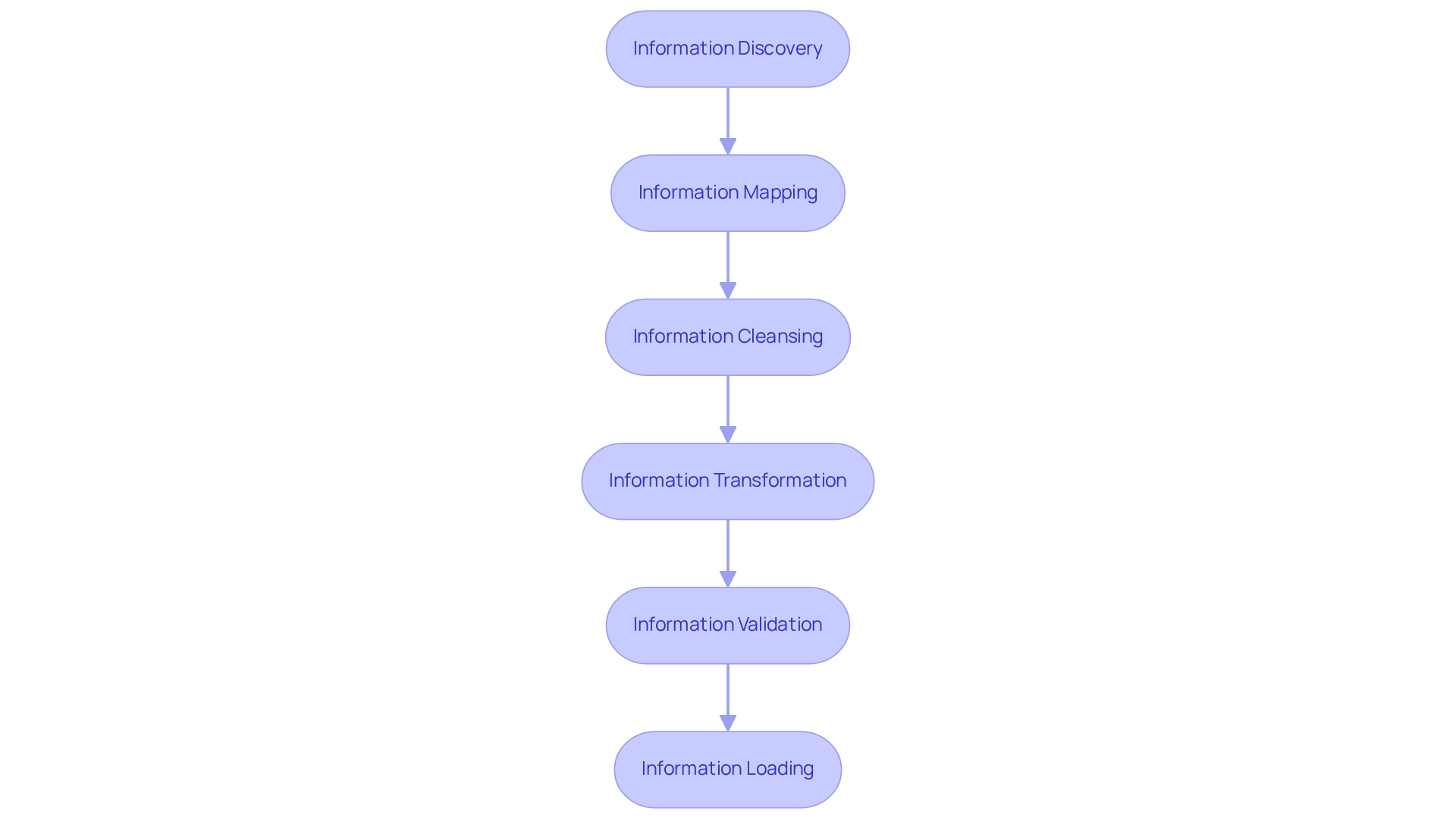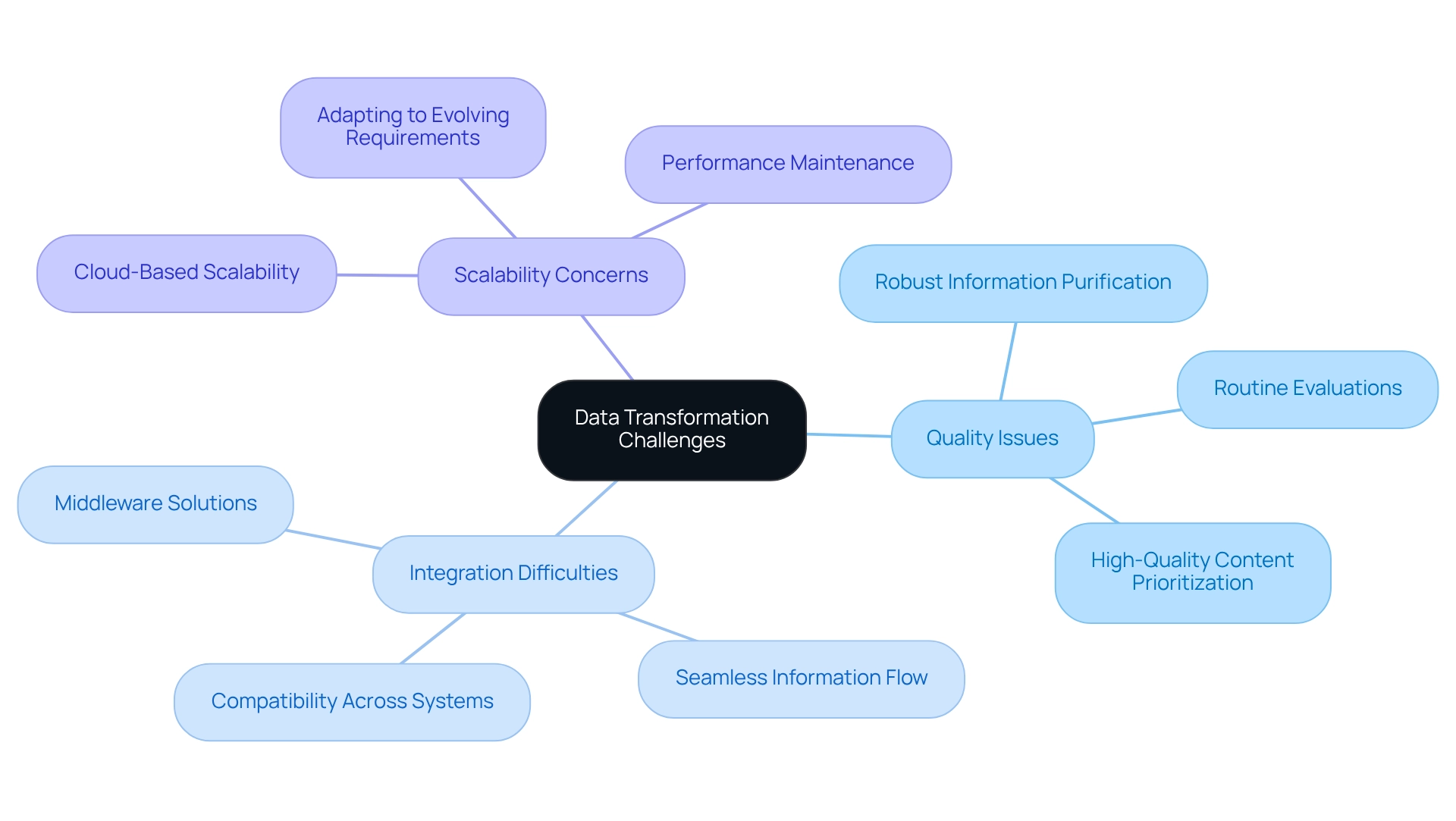Overview
We can master the data transformation process through four straightforward steps:
- Information discovery
- Mapping
- Cleansing
- Transformation
This systematic approach leads to significantly enhanced data quality and usability, which are crucial for effective decision-making. By adhering to these steps, we empower organizations to tackle challenges such as quality issues and integration difficulties. As a result, operational capabilities are strengthened, paving the way for superior business outcomes.
What obstacles are holding your team back? Let us guide you through this transformation to achieve remarkable results.
Introduction
In an era where data drives decision-making, we recognize that transforming raw information into actionable insights is essential for organizations across various sectors. Data transformation is a meticulous process that involves:
- Converting data
- Cleansing data
- Structuring data
This ensures it is not only usable but also reliable for strategic planning. As industries such as banking and healthcare increasingly depend on data integrity and security, the significance of effective data transformation has never been more pronounced.
With innovative platforms like Avato leading the charge, we empower businesses to unlock the potential of their data, streamline operations, and enhance overall performance. This article delves into the intricacies of data transformation, outlining its importance, the steps involved, and the tools and techniques that can help organizations navigate the complexities of modern data landscapes.
Define Data Transformation and Its Importance
The data transformation process is not just a method; it serves as the cornerstone of effective decision-making in today’s data-driven world. We understand that the data transformation process, which involves converting, cleansing, and structuring raw information into a format suitable for analysis, is essential for organizations that depend on insights to shape their strategies. By effectively utilizing the data transformation process, we can enhance quality, improve usability, and ensure compatibility across diverse systems. The critical nature of the data transformation process is particularly evident in industries such as banking and healthcare, where integrity and security are paramount for compliance and operational efficiency.
At Avato, we simplify the integration of disparate systems through our dedicated hybrid integration platform, enabling organizations to unlock isolated assets and enhance business value. Our platform boasts key features such as seamless connectivity, real-time processing, and robust security measures that ensure compliance with industry standards. In fact, in 2021, an impressive 78% of office-based physicians and 96% of non-federal acute hospitals had incorporated a certified Electronic Health Record (EHR), underscoring the healthcare sector’s commitment to transformation. This integration not only streamlines operations but also significantly improves patient care through enhanced information accessibility. Similarly, financial institutions that adopt data-driven decision-making are well-positioned to drive innovation and manage risk effectively, resulting in superior business outcomes. As John Johnstone aptly noted, “Avato possesses the capability to streamline intricate projects and produce outcomes within specified time limits and financial constraints,” highlighting the importance of efficient information integration in achieving these goals.
Real-world examples illustrate the transformative power of information initiatives. For instance, developing economies like China and India are witnessing substantial growth in large-scale analytics, driven by increasing healthcare spending and supportive governmental programs. This trend is set to bolster the healthcare sector’s ability to evaluate and leverage new technologies for improved patient care, showcasing the tangible benefits of the data transformation process.
Furthermore, expert insights indicate that leveraging extensive information in health insurance firms fosters the creation of tailored insurance plans that better meet client needs. By prioritizing the data transformation process, we unleash the potential for enhanced operational capabilities and strategic decision-making, ultimately leading to improved business results. The integration of XML technologies further strengthens the data transformation process by ensuring interoperability and compliance, which are crucial for effective information transformation.
Outline the Data Transformation Process Steps
The data transformation process is crucial for organizations aiming to modernize operations and enhance usability. We recognize that it typically involves several key steps:
- Information Discovery: This initial phase focuses on identifying and understanding various information sources, including their formats and structures. Efficient information discovery lays the groundwork for a successful data transformation process.
- Information Mapping: Here, we define how information from the source aligns with the target format. This ensures that all necessary fields are accounted for, facilitating a seamless transition. Effective information mapping is vital in the data transformation process, as it directly influences the quality of the final output.
- Information Cleansing: This step involves eliminating inaccuracies, duplicates, and irrelevant details to enhance quality. A clean dataset is essential for the data transformation process, which supports reliable analysis and decision-making, particularly in regulated sectors like banking.
- Information Transformation: At this stage, we implement essential modifications to convert the information into the desired format. Utilizing XSLT, a highly-tuned declarative programming language, can significantly streamline the data transformation process. XSLT’s integration with XPath and its extensive library of information manipulation functions allows for efficient handling of XML structures, reducing labor and minimizing programming errors. The inclusion of schemas further enhances the data transformation process by identifying errors during coding, leading to substantial cost savings and ensuring information integrity. To apply this practically, we recommend creating user manuals that outline specific XSLT functions and schema validations pertinent to our transformation requirements.
- Information Validation: This phase ensures that the transformed information meets necessary standards and is ready for analysis. Validation is critical in the data transformation process to prevent errors that could compromise the integrity of the information.
- Information Loading: Finally, we load the transformed information into the target system or database for further use. This stage marks the culmination of the data transformation process, allowing us to utilize our information efficiently.
Statistics reveal that 36% of firms are increasing their budgets to support remote workforces, underscoring the growing importance of effective information integration methods that can facilitate remote operations in the banking industry. As the healthcare sector emerges as a focal point for digital investment, the need for robust information conversion strategies becomes even more apparent. By 2025, we must adapt our information conversion methods to remain competitive, especially since only 11% of companies believe their existing frameworks will sustain in a post-COVID environment. Miro Kazakoff, a senior lecturer at MIT Sloan, emphasizes that “In a world of increased information, the companies with more information-literate individuals are the ones that are going to succeed,” highlighting the critical role of information literacy in managing these processes. By mastering these steps, we can ensure our organizations are well-prepared to navigate the complexities of information integration and change.

Implement Data Transformation Techniques and Tools
To execute the data transformation process efficiently, we recognize that organizations can employ a range of methods and instruments that enhance quality and usability, particularly in the banking industry where dependability and precision are crucial. Our hybrid integration platform plays a vital role in this operation, ensuring 24/7 uptime for essential integrations and simplifying intricate integration projects.
-
Techniques:
- Data Cleansing: This process involves correcting or removing inaccurate records from a dataset, which is crucial for maintaining data integrity. Effective information cleansing techniques can enhance accuracy by up to 30%, significantly influencing decision-making processes.
- Normalization: This technique adjusts values in the dataset to a common scale without distorting differences in the ranges of values. Normalization is crucial for ensuring that analysis produces precise outcomes, as it can improve the accuracy of analysis by about 20%.
- Aggregation: Summarizing information provides a more comprehensive view, such as calculating averages or totals. This technique allows us to derive insights from large datasets efficiently, facilitating better strategic decisions.
- Encoding: Transforming categorical information into a numerical format that can be easily processed by algorithms is essential for machine learning applications. This step ensures that information can be effectively utilized in predictive analytics.
-
Tools:
- ETL Tools: Tools like Talend, Apache Nifi, and Informatica are instrumental in facilitating the extraction, transformation, and loading of data. These tools simplify the information conversion process, enhancing its efficiency and reducing the likelihood of mistakes.
- Data Preparation Tools: Solutions such as Alteryx and Trifacta assist in cleaning and preparing information for analysis, ensuring that the information is ready for insightful analytics.
- Cloud Services: Platforms such as AWS Glue and Google Cloud Dataflow provide scalable solutions for information processing in cloud settings, allowing us to manage large volumes of information effortlessly.
In the context of banking, utilizing these techniques and tools can significantly enhance the data transformation process, leading to improved operational capabilities and reduced expenses. Our hybrid integration platform has been praised for its ability to accelerate secure system integration, as demonstrated in its successful implementation with Coast Capital, where we facilitated a major system transition with minimal downtime. As Tony LeBlanc from the Provincial Health Services Authority remarked, “Avato speeds up the unification of isolated systems and fragmented information, providing the connected foundation enterprises require to simplify, standardize, and modernize.” This highlights the essential function of efficient data transformation process in today’s analytics-focused environment.
Identify Challenges and Solutions in Data Transformation
Information transformation presents significant challenges that organizations must navigate effectively. Quality Issues are paramount; poor quality can lead to misleading insights, jeopardizing decision-making. We recognize the critical need for robust information purification methods and routine evaluations to ensure the integrity of the information we handle. With the staggering volume of data generated—now reaching 5 exabytes every two days—prioritizing high-quality content has never been more essential. Our hybrid integration platform empowers companies to maintain information quality by unlocking isolated assets and facilitating structured requirements management, ensuring that integrity is preserved throughout the data transformation process, while also addressing the challenges posed by complex information structures that complicate the transformation journey. We understand that navigating intricate formats can be daunting. That’s why we employ sophisticated information mapping tools, enabling entities to manage diverse information types effectively and ensuring compatibility across systems.
Integration Difficulties frequently arise when merging transformed information into existing systems. Our middleware solutions are designed to facilitate smoother integration, allowing information to flow seamlessly across platforms and enhancing operational efficiency—particularly crucial in regulated sectors where legacy systems are prevalent.
Scalability Concerns grow as information volumes increase. We offer cloud-based solutions that provide essential scalability, enabling organizations to adapt to evolving information requirements without sacrificing performance. By anticipating these challenges and applying the right solutions, we can significantly enhance your data transformation process, which will lead to improved outcomes and a stronger competitive advantage in your sector. To discover how we can streamline your data transformation efforts through structured requirements management, contact us today!

Conclusion
Data transformation is not just important; it is essential for organizations aiming to convert raw data into actionable insights. This process encompasses data conversion, cleansing, and structuring—critical components for ensuring data quality and compliance, particularly in sectors such as banking and healthcare where integrity is paramount.
The steps of data transformation—discovery, mapping, cleansing, transformation, validation, and loading—provide a structured approach for modernizing operations. Each phase guarantees that the final data output is reliable and primed for analysis, thereby facilitating informed decision-making.
By employing effective techniques and tools, such as our hybrid integration platform, we can significantly enhance the data transformation process. Techniques like data cleansing and normalization not only improve accuracy but also usability, which is vital for generating meaningful insights. As organizations confront challenges in data quality and integration, implementing robust solutions becomes imperative for maintaining a competitive edge.
In conclusion, prioritizing data transformation unlocks the potential to drive innovation and operational efficiency. By adopting these strategies, we can effectively harness our data, leading to improved decision-making and superior outcomes in an increasingly data-driven landscape. What’s holding your team back from embracing this transformation? Let us guide you towards realizing the full potential of your data.

